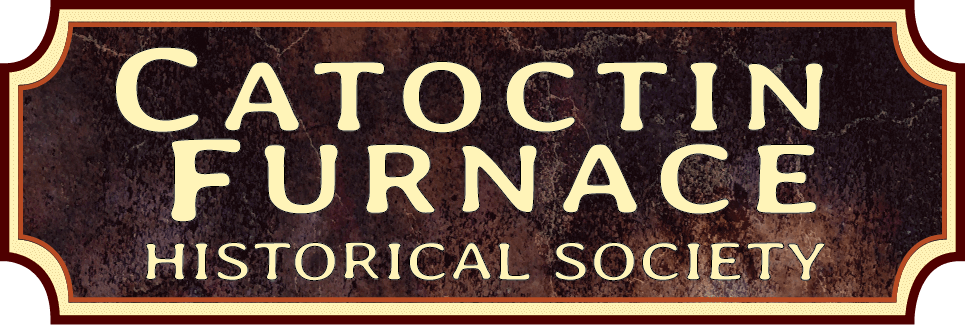The village is located south of Thurmont in Frederick County, within the Catoctin Furnace Historic District. The below structures sit at the heart of this unique pre-Revolutionary industrial village that maintains the layout and structures built between 1774 and 1820, with remarkably few modern intrusions.
Collier’s Log House
The double log house at 12607 Catoctin Furnace Road, now the headquarters of the Catoctin Furnace Historical Society, Inc., is unusual in Catoctin Furnace as it is the only extant double log house. It was home to furnace worker families for over two centuries. Restored in the 1980’s, it is now a museum and interpretive center telling the story of Catoctin Furnace and the iron-making enterprise at the village’s center. The exact construction date of the house is unknown, but it is assumed that the larger section was constructed first around 1810 and the smaller section added about 1830.
Museum of the Ironworker
The Museum of the Ironworker at 12610 Catoctin Furnace Road is located in a circa 1820 worker’s stone house. The building retains a remarkable amount of the original historic features, including portions of the flooring, plaster, fireplace, and interior framing. The Museum includes exhibits such as artifacts, two forensic facial reconstructions of late 18th century enslaved workers at Catoctin, as well as later workers of European descent.
Catoctin Furnace
Today, the stack known as “Isabella” is the focal point of the Catoctin Furnace remains. Built in 1857, “Isabella,” was a sophisticated new furnace powered by steam-operated machinery and a 33-foot-high furnace stack. “Isabella” was in continuous blast until 1893. The 1858 casting shed has been reconstructed next to it. Running northwardly from the complex is a short tramway constructed in the mid-19th century to connect the furnace with ore banks a bit over a mile away just west of US-15.
Forgeman’s House
This building is a beautifully and accurately restored 1820 worker house in the historic village of Catoctin Furnace, surrounded by furnishings and even children’s games matched to the many archaeological artifacts found during the restoration. It has a modern kitchen and bath and will be available for rental in the near future.
Harriet Chapel
The home of the Catoctin Episcopal Parish. John Brien, owner of the Catoctin Iron Furnace (as well as the Auburn mansion), built Harriet Chapel as a memorial to his wife in 1828. Stones used in the construction of the arches in the chancel were taken from the dissembled furnace casting shed about 1924. U.S. Presidents Lyndon Johnson, Gerald Ford, and Jimmy Carter worshipped here with their families and guests.
Ironmaster’s Mansion
The ruins of the Ironmaster’s Mansion sit beside the Isabella Furnace and casting shed. Built in the late 18th century, the mansion was one of 4 large manor houses built by the furnace owners. Displaying their wealth and providing a commanding view of the daily furnace operations, the mansion contained 18 rooms with a fireplace in each room. Boxwoods surrounding the home were removed and planted around the White House in the early 20th century.
